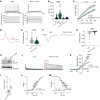Induction of antiviral interferon-stimulated genes by neuronal STING promotes the resolution of pain in mice
- PMID: 38690737
- PMCID: PMC11060736
- DOI: 10.1172/JCI176474
Induction of antiviral interferon-stimulated genes by neuronal STING promotes the resolution of pain in mice
Abstract
Inflammation and pain are intertwined responses to injury, infection, or chronic diseases. While acute inflammation is essential in determining pain resolution and opioid analgesia, maladaptive processes occurring during resolution can lead to the transition to chronic pain. Here we found that inflammation activates the cytosolic DNA-sensing protein stimulator of IFN genes (STING) in dorsal root ganglion nociceptors. Neuronal activation of STING promotes signaling through TANK-binding kinase 1 (TBK1) and triggers an IFN-β response that mediates pain resolution. Notably, we found that mice expressing a nociceptor-specific gain-of-function mutation in STING exhibited an IFN gene signature that reduced nociceptor excitability and inflammatory hyperalgesia through a KChIP1-Kv4.3 regulation. Our findings reveal a role of IFN-regulated genes and KChIP1 downstream of STING in the resolution of inflammatory pain.
Keywords: Inflammation; Innate immunity; Ion channels; Neuroscience; Pain.
Figures








Comment in
- STINGing away the pain: the role of interferon-stimulated genes doi: 10.1172/JCI180497
References
Publication types
MeSH terms
Substances
LinkOut - more resources
Full Text Sources
Molecular Biology Databases
Research Materials
Miscellaneous

